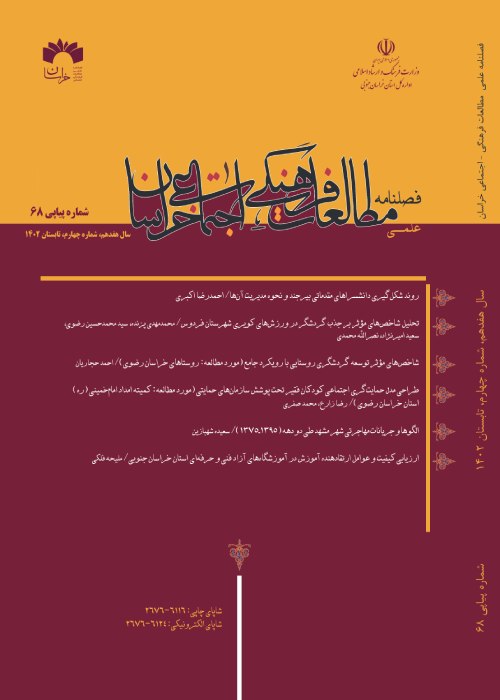An Examination of Factors Influencing Tourist Attraction in Desert Sports Activities of Ferdous City
Today, the tourism industry has become so significant that economists refer to it as a hidden export. This hidden export has seen rapid growth in recent years, and many countries consider it a major source of income. It’s important to note that the large economic cycles driven by tourism can directly enhance the economy and are often more efficient than other income sources for a country, such as oil (Kareemi & Karimi, 2017, p. 32). Desert tourism is a subset of sustainable tourism. For the purposes of this research, desert tourism is defined as “responsible travel to natural areas that conserves the environment and improves the well-being of local people.” The outcomes of adopting a responsible approach to desert tourism include minimizing environmental impact, fostering environmental and cultural awareness and respect, providing positive experiences for both visitors and host communities, generating financial benefits for the protection of nature and natural resources, empowering local communities politically, and acquainting visitors with the political, environmental, and social climate of the host countries. South Khorasan province boasts numerous natural and historical attractions. Proper management of these attractions can significantly contribute to the development of the tourism industry in this province. This research aims to identify the factors that influence the appeal of sports tourism in the Ferdows desert region.
The methodology employed in this research is descriptive, utilizing a survey approach. The statistical population encompasses all sports tourists in the desert area of Ferdous city. Ferdous is a city situated in the north of South Khorasan province. It includes two cities, Ferdous and Islamieh, and the villages of Baghistan, Barun, and Khanekuk, with Ferdous city as the center. The sampling method in this research is probabilistic. Given that the statistical population comprises all sports tourists in the Ferdous desert region, and considering the number of sports tourism areas in Ferdous, 10 sports tourism areas were initially selected. From each area, 40 individuals were randomly chosen as subjects from among the tourists. To determine the sample size for this research, Cochran’s formula was utilized. Based on the classification made in the community section, the number of the statistical sample was approximately 400 people, according to the unlimited statistical population. The questionnaire used in this research is researcher-made and consists of 24 questions. These questions are graded based on a 5-point Likert scale. The content validity of the questionnaire was confirmed by five professors and sports management experts, and the construct validity was appropriately measured and reported through confirmatory factor analysis. The reliability of the questionnaire was also calculated using Cronbach’s alpha coefficient. In this research, SPSS was used to measure descriptive statistics (such as abundance and frequency percentage), and the Structural Equation Model was used to measure inferential statistics with Amos software.
The model developed was validated for the purpose of first-order confirmatory factor analysis of the questionnaire on factors influencing the development of sports tourism, using standard coefficients. All indicators fall within the desired range, confirming the appropriateness of the research measurement model in fitting the collected data. Therefore, the structural model can be fitted to the data in the next step. The goodness of fit index was 0.041, confirming the model’s fit. Also, when the result of dividing the chi-square calculated by the degrees of freedom (df) value is less than 5, the model’s fit is confirmed. In this research, the value of this index is 1.66, supporting the model’s fit. Additionally, when the standard fit index, adaptive fit, criterion fit, relative fit, and goodness of fit are calculated to be higher than or equal to 0.9, the model's appropriate fit is confirmed. The three identified dimensions of factors affecting the development of sports tourism in this study, namely natural attractions, cultural and managerial factors, and infrastructural factors, have influence coefficients of 0.49, 0.34, and 0.19, respectively, on the explanation of this concept. These are high-impact factors and indicate that all three dimensions identified in the formation of the concept of sports tourism in the Ferdows desert region play a relatively similar role. All indicators fall within the desired range, confirming the appropriateness of the research's structural model in fitting the collected data. Therefore, this model can be used to respond to research hypotheses.
The primary objective of this study is to examine the factors that influence the development of sports tourism in the Ferdows desert region. The desert offers a lesser-known tourism potential. The tourism sector has been regarded as the driving force behind the development of cities on the fringes of the Iranian desert. This study assesses the factors that influence the development of sports tourism, and the study’s innovation lies in the application of these factors to desert sports. The results of this study indicate the influence of cultural and managerial factors on sports tourism, with a 34% impact rate. A proposed solution in this field is to invest effectively in cultural and managerial fields in desert regions, transforming half of Iran into a tourism hub in desert areas, attracting domestic and foreign tourists to these areas. Ferdows city, with its pristine desert location and natural attractions, can serve as a platform for desert-specific sports and multilateral desert tournaments. Additionally, considering the city’s cultural ambiance and effective management system, tourism, particularly sports tourism, can be integrated into urban development plans, enabling the construction of numerous recreational and tourist facilities in the region. Moreover, by training human resources, employing experts, and implementing proper management strategies and decisions, a significant step can be taken towards the development of this crucial sector.
- حق عضویت دریافتی صرف حمایت از نشریات عضو و نگهداری، تکمیل و توسعه مگیران میشود.
- پرداخت حق اشتراک و دانلود مقالات اجازه بازنشر آن در سایر رسانههای چاپی و دیجیتال را به کاربر نمیدهد.


